Product Requirements:
Desktop:
Windows 98, or 2000, USB Port
PDAs (Personal Digital Assistants) have sure come a long way since the
chicklet keyed Sharp Wizard clamshell devices. Way back in 1988, when the Wizard
was first introduced, these devices weren’t even called PDAs. Instead, they were
called Electronic Organizers. At that time, the Wizard was king, and a PalmPilot
was still just an idea yet to be thought of by Jeff Hawkins.
In 1994, the Sharp Wizard evolved into the Zaurus, another
clamshell organizer. Then eventually the Zaurus grew into a color handheld device that was only available in
Japan (why do they always get the cool stuff?). Now, Sharp has once again
updated the Zaurus, this time into a small form factor Linux / Java PDA.
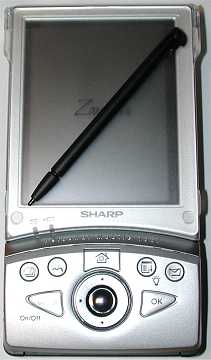
Review disclaimer: This is a review of the SL-5000D.
This is the developers version of the SL-5500, which will go on sale early next
year. As of this writing, the main differences between the developers version
and the consumer version of this device will be the amount of included RAM and
different operating system changes
/ tweaks /additions. The SL-5500 will have 64mb of RAM, while the
developers version has 32mb of RAM. The rest of the hardware will be
identical between the two devices.
The big difference though will be in the software (operating system). The
SL-5000D that I was given still has some rough edges as far as I’m concerned, and I
didn’t think it would be fair to write a full review on a product that will
most likely change quite a bit before it is sold to the general public. So, I
have decided to write a strictly hardware review of this device since the
hardware features will remain unchanged. Once the consumer version is available,
I will update this review to finish it up.
With that out of the way, let’s dig into this interesting PDA and check out
the hardware specs.
Hardware Specifications:
Processor: StrongARM (206 MHz 32-bit SA-1110)
Operating System: Linux 2.4 (Embedix)
Memory: 32 MB SDRAM, 16 MB Flash ROM,
Display: 3.5in 240 x 320 pixel, Color Reflective TFT LCD, 16 bits (65,536
colors)
Power: Removable, rechargeable 3.7V Lithium-Ion battery pack, Built-in 3.0V
back-up battery, 5.0V AC adapter
Communications: USB Docking Station, IrDA infrared port
Expansion slot: One CompactFlash Type I / Type II slot, One Secure Digital slot
Audio: Stereo headphone jack
Size: 2.90 x 5.40 x 0.80in. (74 x 138 x 21mm)
Weight: 7.3 oz (206g)
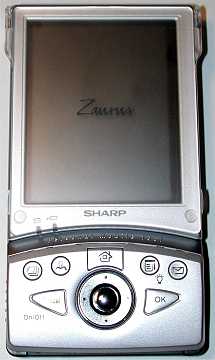
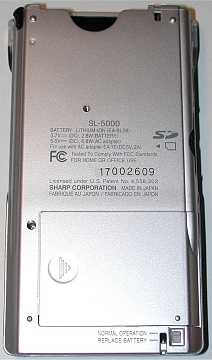
The Zaurus is a very sexy looking device in my opinion. The casing is made of
silver frosted plastic that is very similar in color, appearance, and feel to the Casio
E-100, 105, 115, and 125 Pocket PCs. The body is very solid and does not creak,
crack or flex when squeezed or handled. Size-wise, the Zaurus is bigger and
heavier than the iPAQ, but is pretty close to the HP 565 in both overall size
and weight. It feels good in my hand and is remarkably small and light
considering all of the features that have been packed into it.
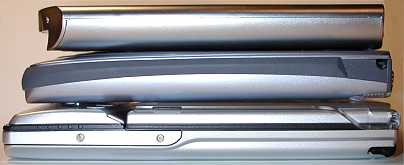 (Top to
(Top to
bottom: iPAQ, HP 565, Zaurus)
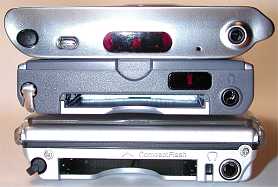
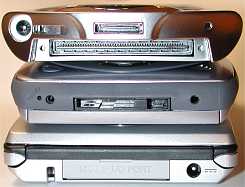
The Zaurus display is protected by a flip-up translucent frosted lid that is
reminiscent of the
Palm III series and Jornada 565 style screen covers. The lid opens to a maximum of ~ 135 degrees and can be
removed if desired. The Zaurus logo is printed in the middle of the lid.
The display is a 3.5in (diagonal) 240 x 320 pixel, color reflective TFT
LCD capable of displaying 65,536 colors. The physical screen size is 2.32 x
2.90in (59 x 74mm) which is the same width as an iPAQ but the same length as a HP 565.
However, the screen has a black border around the edges so that the actual viewable
/ useable area is only 2.1 x 2.7in (53.3 x 69mm). That sounds small, but in
everyday use, the screen ‘feels’ big enough to me.
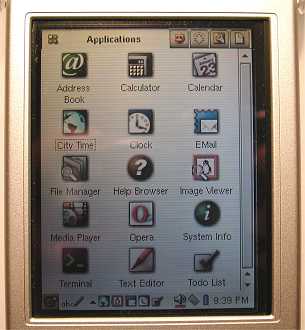
I compared the Zaurus screen to the HP 565 and the iPAQ 3670 screens. Viewing the
same JPG image on all three devices, the Zaurus seems to have the richest
colors. It also is similar to the HP display in that it has a ‘warm up’ period.
When you first turn the PDA on, the display is not as bright as it is will be
after being on for several seconds. I don’t notice this on iPAQ displays. Other
than that, the display looks good indoors and outdoors in full sunlight. It also
has a slick texture so that it is easy to tap and write on with a stylus.
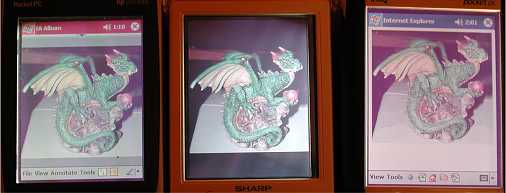 (Left to
(Left to
right: HP 565, Zaurus, 3670 iPAQ)
You might be wondering if the Zaurus is another PDA with the dreaded dust
affliction. I’m sorry to say that it might be. The first unit that was given to
Judie had several large specks that were clearly visible. At the moment, mine
appears to be clear.
Below the display are two LED indicators. The leftmost LED is for email
notification and the right LED is for battery charging status. The email LED
glows green during email operations. I was unable to test email operations for
this review. The battery status LED glows amber while charging and attached to
the AC adapter. This LED will turn off once the battery is fully charged.
Next we have the application button area. Wow, the Zaurus has more buttons on
the front than any other PDA that I can think of. The top row of buttons launch
the Calendar, Address Book, Home, Menu / front light toggle, and E-Mail
applications. Below the
top row of buttons is the On/Off button which doubles as a Cancel button, the
Cursor pad, Select button, and the Ok button. The small round buttons are
slightly concave and sit a little higher than the casing around them. The other
buttons are more convex. They all have great tactile feedback so you don’t have
to guess when you’ve pressed them. The Cursor / Select button is just plain
great. It is a two piece button with the outside being the cursor control and
the inside being the select button. The outside collar can be pressed in 4
directions. The inside button is used as a Select. This cursor / select combo
button is my favorite style of all the Pocket PCs that I’ve used to date. It is a good
size and is easy to manipulate with one hand.
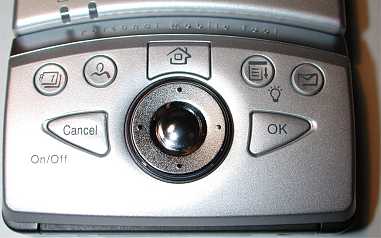
There is one thing that I hope they ‘fix’ with the consumer version. When you
press the On/Off button, there is a slight pause and then the Zaurus will power on with the front light turned
off. After 1 or 2 seconds, the front light will then come on. This only takes 2-3
seconds total, but it just doesn’t feel right after using Pocket PCs and Palm devices that
have no lag in powering on and off. Same goes for turning the unit off.
You have to actually hold down the On/Off button for a couple seconds. Then the
unit will click, the front light will turn off and then the unit will power off.
Of course, you’re wondering about the built-in keyboard right? Well, hidden
under the application and cursor pad buttons, is where you will find the yummy
candy center. To get to it, you can grip the ridges on the sides with one hand
and pull down, or you can use the tips of your thumbs to pull down the sliding
cover. The cover slides down and clicks securely in place revealing a nifty
thumbtype-style keyboard underneath.
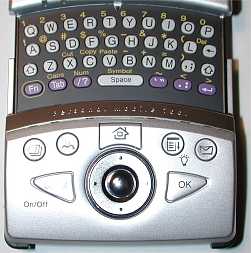

This keyboard has 37 hard white and purple plastic keys that are arranged in
the typical QWERTY format and give really good tactile feedback when pressed.
The easiest way to use this keyboard is to cradle the Zaurus between your two
your hands and use your thumbs to press the keys. This works remarkably well and
allows for pretty quick and reasonably comfortable typing. I think this keyboard
feels a little easier to use than the RIM
Blackberry 950; I would always seem to get cramps in in my hands while using
it. I didn’t have this problem with the Zaurus. Probably because there is more
to hold on to.
While you are using the keyboard, the application buttons and cursor pad are
still active. I actually found out that you can use the cursor pad in
conjunction with the SHIFT keys to select blocks of text. You can then use the
FN C and FN V key combinations to copy and paste text. Another interesting
feature that I came across is the fact that the Select button (middle of the
cursor pad) can function the same as the Space key.
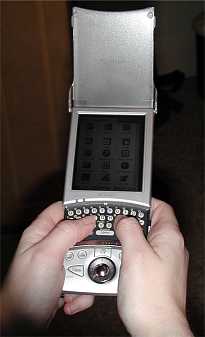
There are a couple little things that I don’t like about the keyboard though.
One is that the keys are hard and slick. I think rubber keys might have been a
better choice. I tend to use my thumbnails to press the keys and sometimes I
slide off. I also don’t like the location of the "?" key. It is on the left
side of the bottom row. For touch typists like myself, this is the opposite of
where I’m used to it being located. Other than those two little personal
annoyances, I find the addition of the keyboard to be terrific! It gives people
yet another method of inputting data, and I’m all about options.
The bottom of the Zaurus has the AC adapter port, lanyard hitch and serial
connector. The AC adapter can be plugged directly into the bottom of the PDA for
charging, or it can be plugged into the cradle so that when the Zaurus is in the
cradle, it will charge thru it.
The lanyard hitch location is actually one of two. There’s another one at the top of the unit.
Lanyards, which are more popular in Japan than the US allow you to attach a hand
strap to the PDA so that you can wear it around your neck (not comfortable!) or
as a hand grip. Unfortunately, there wasn’t a lanyard included with the Zaurus.
The serial connector has a plastic door covering it that can be opened and
slid into the bottom of the PDA. You have to uncover the connector when you want
to charge or sync in the included cradle. The cradle is a light weight blob of
plastic. It really doesn’t differ from most USB PDA cradles. There is a sync
button on the front and an AC adapter connector on the back. There is also an
I/O port on the back which I’m not exactly sure of its function. I’ll assume
that it could be used for an optional serial cable for those people that don’t
want to use USB.
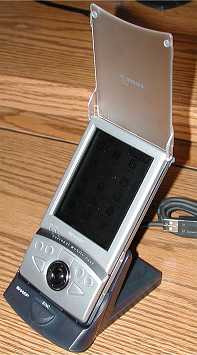
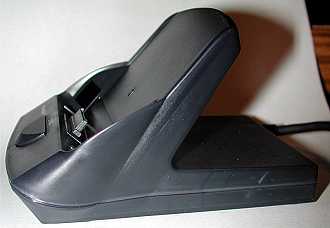
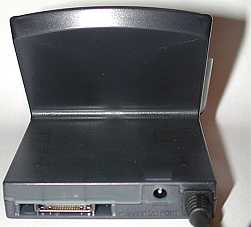
The left side of the Zaurus is the location of the IR port and Secure Digital
(SD) / MultiMedia (MMC) card slot. I’m not too thrilled with the IR port
location, I much prefer it to be at the top of the unit. Having it on the side
makes it harder to beam data to people and to use it for such things as a TV
remote control. At the time of this review, I was unable to test the IR strength
due to the fact that none of the built in apps actually support it yet.
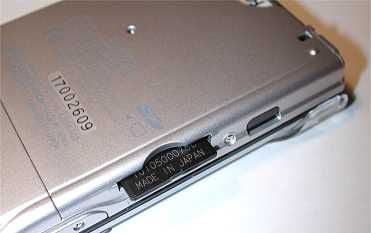

The SD / MMC slot is one of two expansion slots on the Zaurus. It’s great that
it has been included because it allows you to use this slot for memory expansion
while using the CF slot for other things such as CF wireless cards, modems, etc.
The slot itself is spring loaded. You just press the card into the slot and it
locks in place. Press it again and it ejects.
The other expansion slot is the Compact Flash slot which is on the top of the
unit. This is a Type I/II slot, so you can use the
thicker MicroDrives. I tested several of my CF cards, including a 256mb Mr. Flash
card, and they all worked just fine with the Zaurus.
Also at the top of the PDA is the stylus silo, a lanyard hitch and the earphone
jack. The stylus silo is the typical friction insert type. The stylus is also
your run of the mill plastic toothpick. This one is somewhat shorter and fatter
than average though.
The earphone jack is a standard 3.5mm sized jack that actually does dual duty.
Besides being a stereo earphone jack, it is also a mono microphone jack. You
will need to buy a combination earphone / mic device to take advantage of this
feature though. Unfortunately, I was unable to test the recording quality
because the software does not support it at the moment.
Unlike the current crop of Pocket PCs, the Zaurus can not play MP3’s or other
‘real’ audio thru the internal speaker. You must listen thru headphones. The
internal speaker is a piezo buzzer which means that it will really only play
beeps, boops and clicks. To me this is very disappointing because I want to be
able to be able to set alarm sounds that are more interesting then the lame
phone ringer one that is included. I also want to play games that have great sound
without having to wear earphones. That said, the stereo output thru
headphones sounds great! I think the Zaurus has the best sound quality for
playing MP3’s of any PDA that I’ve tested so far. The volume level is also quite
good. Compared to my HP 565 and iPAQ 3670, it is about 10% louder than the HP
and about 20% quieter than the iPAQ. I never listen to MP3’s on the highest
volume setting anyway, so I find the levels to be perfect.
The back of the Zaurus is plain except for the removable lithium-ion
rechargeable battery pack and the battery replacement switch. The switch is a
lock for the battery cover and also functions as a soft reset switch. If you
take off the cover, you then will see the battery and a full reset switch.
Pressing the full reset switch will erase any information that you have saved
directly on the PDA.
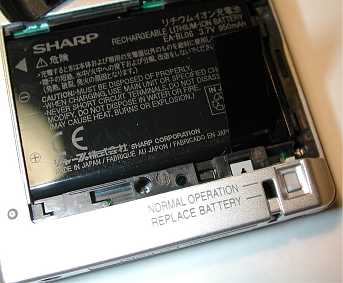
There is also a built-in rechargeable back-up battery inside the Zaurus. It
isn’t something that can be replaced though like a coin cell. It prevents the
memory contents from being erased when you replace the main battery. It is
charged along with the main battery when in PDA is in the cradle and attached to
AC power.
So far, I’ve noticed that battery life is close to that of my 3670 iPAQ. It
really depends on what you use the PDA for as to how much life you should expect
per charge. Just playing MP3’s yielded me approximately 3hrs of use. By using
the MENU button, you can turn off the display’s front light, but there isn’t a
feature to turn the display totally off like you can on a Pocket PC.
Overall system speed seems to be on par with other StrongArm devices such as
the iPAQ and HP 565. I took a few minutes to sit and open apps one after another on
my iPAQ and HP and then did the same with the Zaurus. I didn’t notice any real
differences in launch speed between all of the devices.
As far as the hardware goes, Sharp has a real winner in the Zaurus SL-5000D.
It is a solid PDA packed with great features, while not being overly bulky.
Including both CF and SD/MMC slots is a big plus, and the built-in keyboard gives
this device a real gee whiz flare. If I had to change anything regarding the
hardware, it would be to give the Zaurus a real internal speaker on par with the
Pocket PC, move the IR port to the top of the unit and take away the lag with
powering the unit on and off. Other than that, I
could honestly say that I would love for this device to be my main PDA. But,
there’s that little matter of the operating system….
The OS as it is on this developers unit is still rough. It doesn’t feel as
polished as the Pocket PC or Palm. The main PIM apps just aren’t ready for the
masses as far as I’m concerned. They seem flat and sorely lacking in advanced
features. However, I do like the style of the interface. For Linux users, it has
that KDE look to it and is called Qtopia from
Trolltech. Qtopia is the GUI and a core
set of applications which include: an Address book, To-Do List, Appointment
Calendar, E-Mail client, Opera Web Browser, a multimedia player capable of
playing MPEG1, MPEG2, and MP3 format files, image viewer, Command Line Terminal
and File Manager, Text Editor, Calculator, City Time app, and several games,
including Asteroids, Go, Mindbreaker, Mine Hunt, Patience, Snake, Tux and Word
Game (Judie and I both loved this Scrabble clone!).
Below are some screenshots that I lifted from Trolltech’s website. Visit it
to see more.
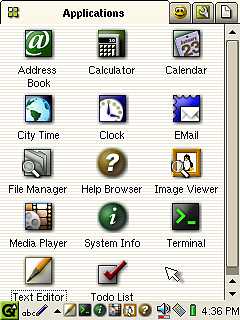
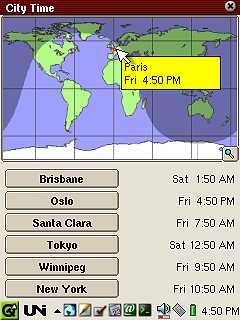
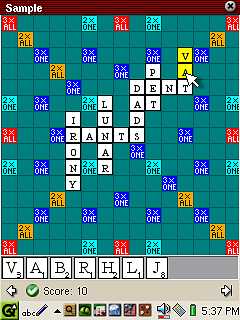
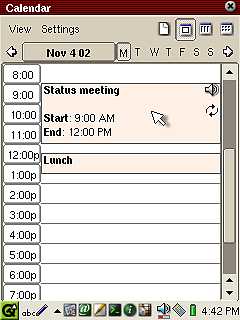
It’s always fun to play with a new PDA, and this one was no different in that
respect. But after playing with it for several hours, I realized that it
couldn’t be my main PDA until the software becomes a little more robust. Sure, if this
device takes off, there is going to be a large community of developers that will
rally behind it and create better applications. Right now, it has a big appeal for hackers and Unix geeks which
is great, but it doesn’t feel like a consumer device for the average person. If this device were running Pocket PC 2002, I would say that Sharp might
have created the next golden child of the PDA world. But since they decided to
go with Linux and Java, it makes me wonder if they will be able to succeed. The
Pocket PC is only just now gaining on Palm in the battle of the PDA OS’s after
being on the frontline for several years now. Bringing yet another OS into the
fray seems like a mistake to me. But I will withhold my judgment until I see the
actual consumer version. I will be anxiously waiting to get my hands on one to
review.
Price: $399
Pros:
Built-in keyboard
SD/MMC and CF slots
Great stereo output thru headphones
Cons:
Internal speaker inferior. Needs earphones to listen to MP3’s etc.
Operating system needs work
Pause in powering up and powering down
Core apps need more polish and features
Learn How to Use Linux, Linux Mint Cinnamon 22 Bootable 8GB USB Flash Drive - Includes Boot Repair and Install Guide Now with USB Type C
$22.95 (as of 12/27/2025 17:00 GMT -06:00 - More infoProduct prices and availability are accurate as of the date/time indicated and are subject to change. Any price and availability information displayed on [relevant Amazon Site(s), as applicable] at the time of purchase will apply to the purchase of this product.)Linux Basics for Hackers: Getting Started with Networking, Scripting, and Security in Kali
11% OffProduct Information
| Price: | 399.0 |
| Manufacturer: | Sharp |
| Pros: |
|
| Cons: |
|


